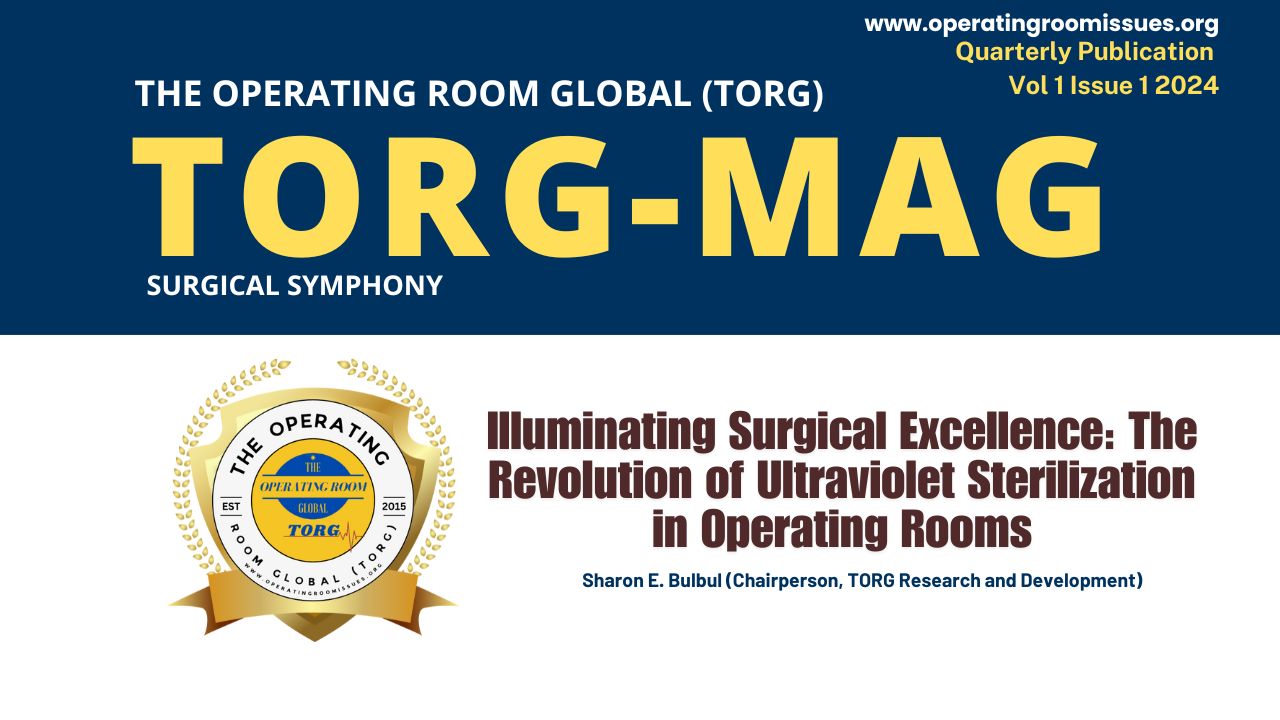TORG-MAG Vol 1 Issue 1, Aug. 2024, PP. 31-32
By Sharon E. Bulbul, Chairperson TORG Research & Development
Cite this article: Bulbul, S.E. (2024) ‘Illuminating Surgical Excellence: The Revolution of Ultraviolet Sterilization in Operating Rooms’, TORG-MAG, Vol. 1, Issue 1, pp. 31-32. Available at: https://torgevents.org/illuminating-surgical-excellence/
Introduction

The integration of ultraviolet (UV) sterilization technology within surgical environments marks a paradigm shift in ensuring pristine sterility crucial for successful procedures and patient recovery. This article delves into the revolutionary impact of UV sterilization methodologies, elucidating their efficacy, safety, and broader implications. Highlighting its non-toxic nature and remarkable efficiency in neutralizing pathogens, emphasizing the pivotal role of UV sterilization in reducing surgical site infections and enhancing patient outcomes.
The integration of ultraviolet (UV) sterilization technology within surgical environments marks a paradigm shift in ensuring pristine sterility crucial for successful procedures and patient recovery. This article delves into the revolutionary impact of UV sterilization methodologies, elucidating their efficacy, safety, and broader implications. Highlighting its non-toxic nature and remarkable efficiency in neutralizing pathogens, emphasizing the pivotal role of UV sterilization in reducing surgical site infections and enhancing patient outcomes.
While acknowledging challenges in implementation, ongoing advancements in UV sterilization technology herald a future where surgical environments achieve unparalleled levels of cleanliness and safety. As UV sterilization transcends surgical boundaries, its broader implications for human health and environmental hygiene become increasingly evident, underscoring its potential as a cornerstone in healthcare facility safety protocols.
In the relentless pursuit of perfection within the medical field, the quest for impeccable sterility in surgical settings stands as a cornerstone of patient care. Enter ultraviolet (UV) sterilization—a cutting-edge methodology revolutionizing the landscape of surgical practices worldwide. This innovative approach harnesses the power of UV light to combat pathogens, ensuring a pristine, sterile environment crucial for successful surgeries and patient recovery.

Historically, UV light’s germicidal properties have been acknowledged for their ability to dismantle the DNA and RNA of microorganisms, rendering them harmless [1].
However, recent advancements have elevated UV sterilization, refining its efficacy and safety, making it a promising solution for maintaining sterile surgical environments. The beauty of UV sterilization lies in its non-toxic nature, a stark departure from conventional disinfection methods reliant on harsh chemicals [1]. This paradigm shift mitigates the risk of chemical residues or allergic reactions, fostering a safer environment for patients, surgeons, and operating room staff. The elimination of such risks addresses long-standing concerns associated with traditional sterilization techniques [1].
Precision and comprehensiveness are imperative in surgical theaters. UV sterilization systems are meticulously engineered to emit specific wavelengths, adept at targeting and eradicating a broad spectrum of pathogens such as methicillin-resistant Staphylococcus aureus (MRSA), vancomycin-resistant enterococci (VRE), carbapenem-resistant Enterobacteriaceae (CRE), and extended-spectrum beta-lactamase producing Escherichia coli viruses, and fungi [1]. These systems are designed to efficiently disinfect surfaces, equipment, and even the air, bolstering the defense against surgical site infections (SSIs) and ensuring a meticulously sterile environment [2]. The efficiency of UV sterilization is undeniably impressive. In a matter of minutes, UV light can effectively neutralize pathogens, drastically reducing the risk of SSIs [3].

This rapid and thorough sterilization process plays a pivotal role in safeguarding patients from post-operative complications and infections, thereby enhancing recovery and overall outcomes.
The integration of UV sterilization technology into surgical protocols has yielded tangible benefits.
Studies have demonstrated a significant reduction in SSIs and hospital-acquired infections post-implementation of UV sterilization methods [1]. Beyond improving patient outcomes, this reduction has a substantial impact on healthcare economics, curtailing costs associated with extended hospital stays and additional treatments [1].
Nevertheless, the adoption of UV sterilization in surgical settings does present challenges. Proper training for personnel handling these systems is crucial, ensuring they understand optimal exposure times and addressing limitations in reaching shadowed areas within the operating room. Continuous refinement and education are imperative to maximize the potential of UV sterilization technology. Looking ahead, the future of UV sterilization in surgery holds immense promise.
Ongoing research endeavors seek to enhance the efficiency and accessibility of these systems. Innovations in portable UV devices and automated sterilization systems are on the horizon, potentially making this technology more adaptable across various healthcare settings. While UV sterilization presents a paradigm shift in ensuring surgical sterility, its integration necessitates a multidimensional approach. Collaboration between medical professionals, engineers, and researchers is pivotal to further refine and optimize this technology. Addressing challenges and refining protocols will facilitate the seamless integration of UV sterilization into existing surgical practices, ushering in an era of unprecedented cleanliness and safety [1].

In conclusion, UV sterilization stands as a monumental leap forward in the pursuit of impeccable sterility within surgical environments. Its non-toxic nature, exceptional efficacy, and potential to minimize infections signify a monumental advancement in patient safety and surgical outcomes. As challenges are met with innovation and refinement, UV sterilization paves the way for a future where surgical settings can achieve unparalleled levels of cleanliness and safety, heralding a new standard of excellence in patient care.
References
1. Clysly Celine R. Ramos., Josemaria Lorenzo A. Roque., Diane B. Sarmiento., Luis Enrico G. Suarez., Janela Tanya P. Sunio., Kaezzy IIa B.Tabungar., Geraldine Susan C. Tengco., Phyllis C. Rio., and Allan L. Hilario. Use of ultraviolet- C in environmental sterilization in hospitals: A systemic review on efficacy and safety. International journal of health sciences, Vol 14. no. 6 (2020): 52- 65.
2. Ahmad, I. Shamim. Ultraviolet Light in Human Health, Diseases and Environment. (Nottingham, UK: Springer, 2020).
3. Manuela Buonanno, Milda Stanislauskas, Brian Ponnaiya, Alan W. Bigelow, Gerhard Randers-Pehrson, Yanping Xu, David J. Brenner, David M. Owens, Igor Shuryak, Lubomir Smilenov. 207 -nm UV Light- A Promising Tool for Safe Low-Cost Reduction of Surgical Site Infections. II: In-Vivo Safety Studies. PLOS ONE, Vol 11. No. 6 (2016).
TORG Magazine (TORG-MAG)
Maiden Edition: Surgical Symphony, Issue 1 Vol 1 Aug 2024
Stay ahead in the field of surgical practice with TORG-MAG, the quarterly publication from The Operating Room Global (TORG).
✓ Fill out the Form Below and submit
